Well, not all of them, just the ones I've got good pictures of on photobucket. ;-)
I've already posted about 'Wild Man Valley', the strange area a couple of hours from our cabin where the flora is so different from the surroundings for many many kilometers. There are so many species of plant growing there, and in such abundance. It's quite amazing, a sight not to be missed if one ever gets the chance. :-)
Ferns and other large plants. Many species grow to unusual size in this place, sizes they could never achieve only some tens of meters from this site.
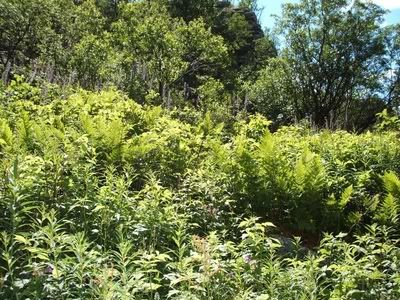 The purplish plants you see here are called tyrihjelm (Aconitum lycoctonum). I'm not sure what the name means, except that hjelm means helmet. The popular name for the plant in the East Valley is lushatt, which means louse hat - the plant can be used to make an effective remedy against head lice. I think this is most often called wolfsbane in English.
The purplish plants you see here are called tyrihjelm (Aconitum lycoctonum). I'm not sure what the name means, except that hjelm means helmet. The popular name for the plant in the East Valley is lushatt, which means louse hat - the plant can be used to make an effective remedy against head lice. I think this is most often called wolfsbane in English.Buttercups (Ranunculus acris) growing on a miniature island in the river that runs along the valley floor. These are usually called smørblomst in Norwegian - butter flowers. :-)
 These were my grandmother's favorite flowers - linnea (Linnaea borealis). They are tiny and delicate; the flower grows in pairs of beautiful pale pink bells, and they smell of sweet almonds. This is the flower that the greatest of the great botanists, Carl von Linné, picked as the one he wanted to forever bear his own name. This plant tends to grow in certain specific spots - they send out long extended roots that new stems sprout from, so if you find one, you'll always find more. I know the right places to find them in the area around our cabin - of course I know ;-) - and I used to always pick a bouquet of them for my grandmother. She appreciated this especially in the last few years of her life when she wasn't in shape to walk anywhere much herself. But she always got her linnea. :-) I think the English name is twinflower.
These were my grandmother's favorite flowers - linnea (Linnaea borealis). They are tiny and delicate; the flower grows in pairs of beautiful pale pink bells, and they smell of sweet almonds. This is the flower that the greatest of the great botanists, Carl von Linné, picked as the one he wanted to forever bear his own name. This plant tends to grow in certain specific spots - they send out long extended roots that new stems sprout from, so if you find one, you'll always find more. I know the right places to find them in the area around our cabin - of course I know ;-) - and I used to always pick a bouquet of them for my grandmother. She appreciated this especially in the last few years of her life when she wasn't in shape to walk anywhere much herself. But she always got her linnea. :-) I think the English name is twinflower. In this valley they spread out to cover much larger areas than I've ever seen them do anywhere else.
 A closer look at some individual plants. They are so beautiful ... a pity the color doesn't show up very well in these shots. Next summer I'll try to get some better ones, with my new camera, which I haven't had the chance to use up there yet. But also, the flowers do tend to get less pink and more white as the summer wanes.
A closer look at some individual plants. They are so beautiful ... a pity the color doesn't show up very well in these shots. Next summer I'll try to get some better ones, with my new camera, which I haven't had the chance to use up there yet. But also, the flowers do tend to get less pink and more white as the summer wanes.
 The plant grows in various types of forested environment. They love the shade and are often found growing more or less underneath larger species.
The plant grows in various types of forested environment. They love the shade and are often found growing more or less underneath larger species.
 Reinlav or reinmose (Cladonia rangiferina) is extremely common in this area. It grows almost everywhere, and the growths can be very dense, as you see here. The name means reindeer moss - the name is due to the fact that this species is a favorite winter food of the wild reindeer that live in this and other mountainous areas. I think this name is in relatively common use in English too (ie reindeer moss).
Reinlav or reinmose (Cladonia rangiferina) is extremely common in this area. It grows almost everywhere, and the growths can be very dense, as you see here. The name means reindeer moss - the name is due to the fact that this species is a favorite winter food of the wild reindeer that live in this and other mountainous areas. I think this name is in relatively common use in English too (ie reindeer moss).
 Tettegras (Pinguicula alpina). Umm ... butterwort, right? This and the two other Pinguicula species listed here are the only carnivorous plants in this country. No flower, alas ... I was there too late in the year this summer, there were only leaves left on all the specimens I saw.
Tettegras (Pinguicula alpina). Umm ... butterwort, right? This and the two other Pinguicula species listed here are the only carnivorous plants in this country. No flower, alas ... I was there too late in the year this summer, there were only leaves left on all the specimens I saw.
 Geitrams (Epilobium angustifolium) - fireweed in English - which is always colorful, is extra bright at the high altitudes our cabin is at. And this year they were especially vibrant ... I'd never seen them so brightly colored before. Beautiful. The house in the background is the one Hilde and Storm built after retiring as managers at Bjørnhollia.
Geitrams (Epilobium angustifolium) - fireweed in English - which is always colorful, is extra bright at the high altitudes our cabin is at. And this year they were especially vibrant ... I'd never seen them so brightly colored before. Beautiful. The house in the background is the one Hilde and Storm built after retiring as managers at Bjørnhollia.
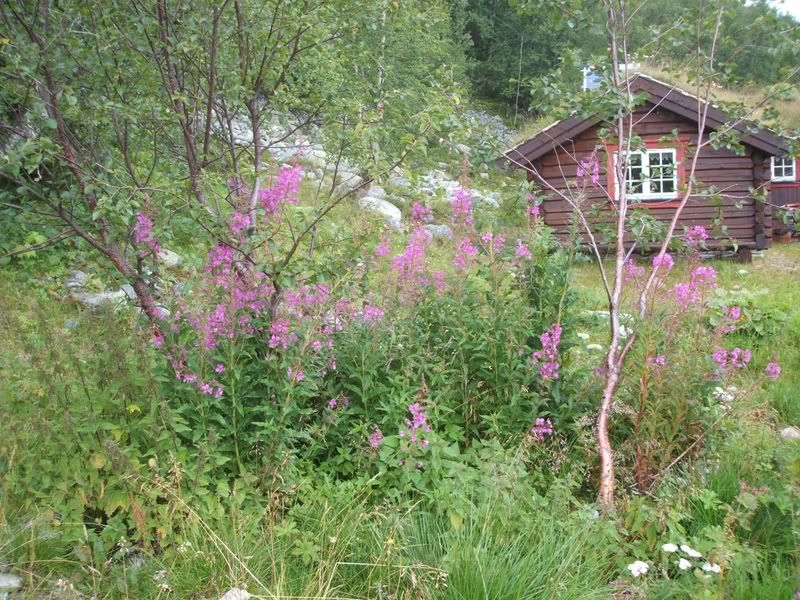 2008 was a lousy year for cloudberries (Rubus chamaemorus), but of course there are always some. They are called multe in Norwegian, and are generally considered an acquired taste. ;-)
2008 was a lousy year for cloudberries (Rubus chamaemorus), but of course there are always some. They are called multe in Norwegian, and are generally considered an acquired taste. ;-)
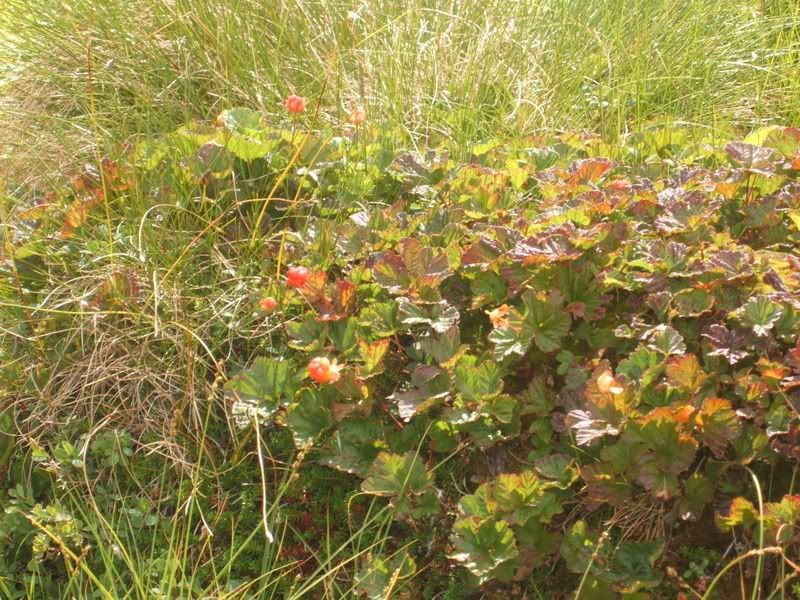 Another very common species of plant in this area is røsslyng (Calluna vulgaris). Yeah, basically heather. :-) It's closely related to the erica species, but it's a separate species. It grows in very varied terrain, but it does prefer open spaces with lots of sunlight. The brightness of the flowers varies from year to year ... this year there were a lot of plants with very strongly colored flowers. Don't ask me why, but it was certainly very pretty. :-)
Another very common species of plant in this area is røsslyng (Calluna vulgaris). Yeah, basically heather. :-) It's closely related to the erica species, but it's a separate species. It grows in very varied terrain, but it does prefer open spaces with lots of sunlight. The brightness of the flowers varies from year to year ... this year there were a lot of plants with very strongly colored flowers. Don't ask me why, but it was certainly very pretty. :-)
 More heather ... this was in more marshy terrain, the picture above is of a dry spot.
More heather ... this was in more marshy terrain, the picture above is of a dry spot.
 My mother picked a huge bouquet of them, which of course was absolutely beautiful. I mean, wow. :-)
My mother picked a huge bouquet of them, which of course was absolutely beautiful. I mean, wow. :-)
 Bluebells (Campanula rotundifolia)!! They are so pretty, I love their color ... pale but still so striking against the mountain grasses. :-) They're called bluebells in Norwegian - blåklokker - but the English name is harebell. These were growing randomly by the side of the road in Røros.
Bluebells (Campanula rotundifolia)!! They are so pretty, I love their color ... pale but still so striking against the mountain grasses. :-) They're called bluebells in Norwegian - blåklokker - but the English name is harebell. These were growing randomly by the side of the road in Røros.
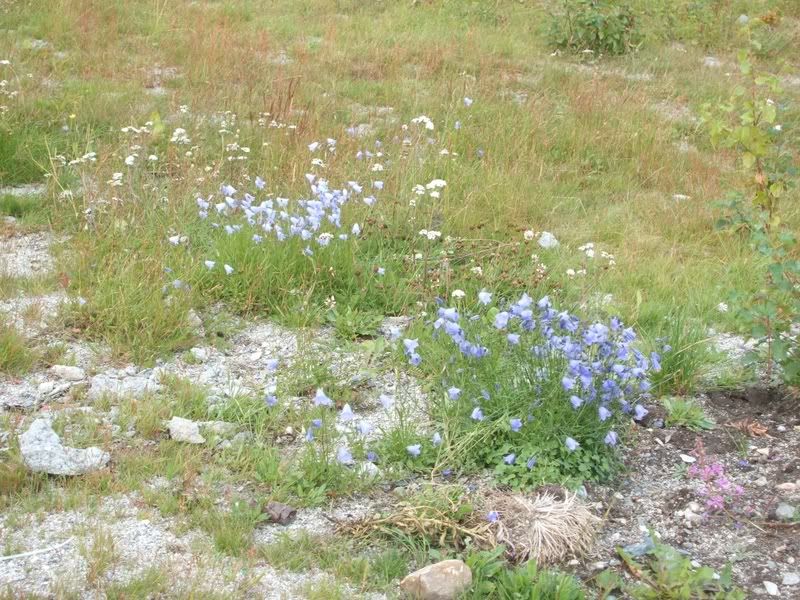 And these were on the stairs in the churchyard there. :-)
And these were on the stairs in the churchyard there. :-)
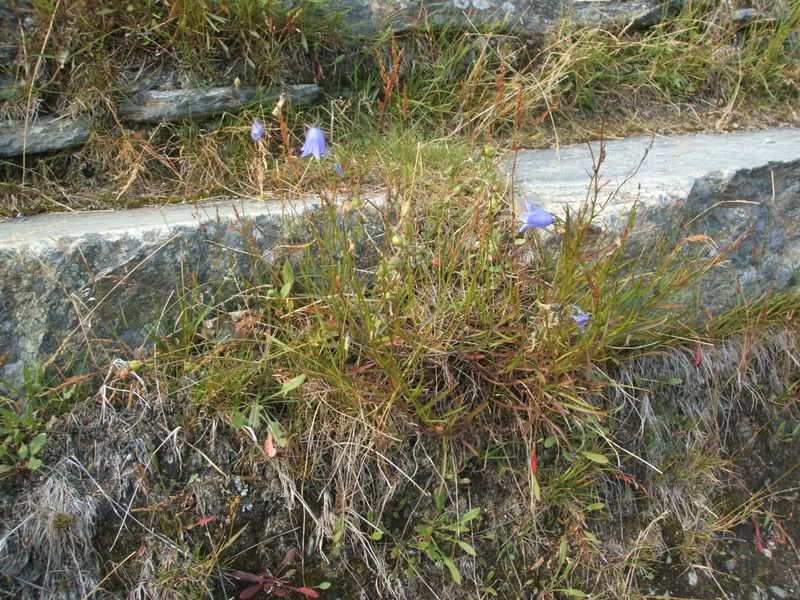 This next plant is one of several closely related species (they differ in color) which grow on sunny open hillsides in mountainous areas. They're pretty rare. The family name in Norwegian is søte, ie sweet ... this purple one is called bittersøte, bittersweet. Not sure about the latin name. I'll find out. The flowers need strong sun to open - when they're closed, which is most of the time, they're very humble and unassuming and very easy to miss ...
This next plant is one of several closely related species (they differ in color) which grow on sunny open hillsides in mountainous areas. They're pretty rare. The family name in Norwegian is søte, ie sweet ... this purple one is called bittersøte, bittersweet. Not sure about the latin name. I'll find out. The flowers need strong sun to open - when they're closed, which is most of the time, they're very humble and unassuming and very easy to miss ...
 This next one is quite common and easy to find - kattefot and harelabb are the common names for it. (Cat's paw and hare's foot. :-) I don't know either the latin name or the correct English name ... I'll do some research. And next summer I'll take some better pictures. :-)
This next one is quite common and easy to find - kattefot and harelabb are the common names for it. (Cat's paw and hare's foot. :-) I don't know either the latin name or the correct English name ... I'll do some research. And next summer I'll take some better pictures. :-)
 And finally, another very rare plant, which I think I've only seen the time a couple of years ago when I took this picture. Maybe a few more times, I'm not sure. Mogop (Anemone vernalis) prefers very rocky ground - as you see - it grows in places where few other plants manage to survive. A very hardy species ... and quite beautiful, although as you see quite tiny.
And finally, another very rare plant, which I think I've only seen the time a couple of years ago when I took this picture. Maybe a few more times, I'm not sure. Mogop (Anemone vernalis) prefers very rocky ground - as you see - it grows in places where few other plants manage to survive. A very hardy species ... and quite beautiful, although as you see quite tiny.
 A closer look at some individual plants. They are so beautiful ... a pity the color doesn't show up very well in these shots. Next summer I'll try to get some better ones, with my new camera, which I haven't had the chance to use up there yet. But also, the flowers do tend to get less pink and more white as the summer wanes.
A closer look at some individual plants. They are so beautiful ... a pity the color doesn't show up very well in these shots. Next summer I'll try to get some better ones, with my new camera, which I haven't had the chance to use up there yet. But also, the flowers do tend to get less pink and more white as the summer wanes. The plant grows in various types of forested environment. They love the shade and are often found growing more or less underneath larger species.
The plant grows in various types of forested environment. They love the shade and are often found growing more or less underneath larger species. Reinlav or reinmose (Cladonia rangiferina) is extremely common in this area. It grows almost everywhere, and the growths can be very dense, as you see here. The name means reindeer moss - the name is due to the fact that this species is a favorite winter food of the wild reindeer that live in this and other mountainous areas. I think this name is in relatively common use in English too (ie reindeer moss).
Reinlav or reinmose (Cladonia rangiferina) is extremely common in this area. It grows almost everywhere, and the growths can be very dense, as you see here. The name means reindeer moss - the name is due to the fact that this species is a favorite winter food of the wild reindeer that live in this and other mountainous areas. I think this name is in relatively common use in English too (ie reindeer moss).Blueberries!! Well, at least what we call blueberries in Norway - blåbær (Vaccinium myrtillus). Very tasty and very healthy. :-) This year was a pretty good year for blueberries in Rondane ... in the sense that there were quite a few of them to be found ... but they weren't all that good. We picked some to eat on all the hikes we went on this summer, but some of them were just ... meh. Kind of watery and tasteless ... bland. But others were really good. And of course they all looked v. pretty. :-)
 Tettegras (Pinguicula alpina). Umm ... butterwort, right? This and the two other Pinguicula species listed here are the only carnivorous plants in this country. No flower, alas ... I was there too late in the year this summer, there were only leaves left on all the specimens I saw.
Tettegras (Pinguicula alpina). Umm ... butterwort, right? This and the two other Pinguicula species listed here are the only carnivorous plants in this country. No flower, alas ... I was there too late in the year this summer, there were only leaves left on all the specimens I saw. Geitrams (Epilobium angustifolium) - fireweed in English - which is always colorful, is extra bright at the high altitudes our cabin is at. And this year they were especially vibrant ... I'd never seen them so brightly colored before. Beautiful. The house in the background is the one Hilde and Storm built after retiring as managers at Bjørnhollia.
Geitrams (Epilobium angustifolium) - fireweed in English - which is always colorful, is extra bright at the high altitudes our cabin is at. And this year they were especially vibrant ... I'd never seen them so brightly colored before. Beautiful. The house in the background is the one Hilde and Storm built after retiring as managers at Bjørnhollia. 2008 was a lousy year for cloudberries (Rubus chamaemorus), but of course there are always some. They are called multe in Norwegian, and are generally considered an acquired taste. ;-)
2008 was a lousy year for cloudberries (Rubus chamaemorus), but of course there are always some. They are called multe in Norwegian, and are generally considered an acquired taste. ;-) Another very common species of plant in this area is røsslyng (Calluna vulgaris). Yeah, basically heather. :-) It's closely related to the erica species, but it's a separate species. It grows in very varied terrain, but it does prefer open spaces with lots of sunlight. The brightness of the flowers varies from year to year ... this year there were a lot of plants with very strongly colored flowers. Don't ask me why, but it was certainly very pretty. :-)
Another very common species of plant in this area is røsslyng (Calluna vulgaris). Yeah, basically heather. :-) It's closely related to the erica species, but it's a separate species. It grows in very varied terrain, but it does prefer open spaces with lots of sunlight. The brightness of the flowers varies from year to year ... this year there were a lot of plants with very strongly colored flowers. Don't ask me why, but it was certainly very pretty. :-) More heather ... this was in more marshy terrain, the picture above is of a dry spot.
More heather ... this was in more marshy terrain, the picture above is of a dry spot. My mother picked a huge bouquet of them, which of course was absolutely beautiful. I mean, wow. :-)
My mother picked a huge bouquet of them, which of course was absolutely beautiful. I mean, wow. :-) Bluebells (Campanula rotundifolia)!! They are so pretty, I love their color ... pale but still so striking against the mountain grasses. :-) They're called bluebells in Norwegian - blåklokker - but the English name is harebell. These were growing randomly by the side of the road in Røros.
Bluebells (Campanula rotundifolia)!! They are so pretty, I love their color ... pale but still so striking against the mountain grasses. :-) They're called bluebells in Norwegian - blåklokker - but the English name is harebell. These were growing randomly by the side of the road in Røros. And these were on the stairs in the churchyard there. :-)
And these were on the stairs in the churchyard there. :-) This next plant is one of several closely related species (they differ in color) which grow on sunny open hillsides in mountainous areas. They're pretty rare. The family name in Norwegian is søte, ie sweet ... this purple one is called bittersøte, bittersweet. Not sure about the latin name. I'll find out. The flowers need strong sun to open - when they're closed, which is most of the time, they're very humble and unassuming and very easy to miss ...
This next plant is one of several closely related species (they differ in color) which grow on sunny open hillsides in mountainous areas. They're pretty rare. The family name in Norwegian is søte, ie sweet ... this purple one is called bittersøte, bittersweet. Not sure about the latin name. I'll find out. The flowers need strong sun to open - when they're closed, which is most of the time, they're very humble and unassuming and very easy to miss ...This is another quite rare plant - Olavsstake (Moneses uniflora), ie, St Olav's candlestick. :-) St Olav (king Olav II the Saint, 1015-30) is our patron saint, and one of the very few Norwegian saints who ever became popular outside of Norway. :-) The old superstition had it that this flower grew in the holy king's footsteps ... and as a result it's distributed widely across the country. The king travelled all over in his efforts to 'convert' us to Christianity (this basically consisted in him telling people that either you accept Christ as your lord or I will burn your houses down and kill you, and people saying hey man, don't do that, we totally accept this Christ guy, just don't burn anything ... and the king having them baptized and then riding away happily and never seeing any of these people again. :-D)
 This next one is quite common and easy to find - kattefot and harelabb are the common names for it. (Cat's paw and hare's foot. :-) I don't know either the latin name or the correct English name ... I'll do some research. And next summer I'll take some better pictures. :-)
This next one is quite common and easy to find - kattefot and harelabb are the common names for it. (Cat's paw and hare's foot. :-) I don't know either the latin name or the correct English name ... I'll do some research. And next summer I'll take some better pictures. :-) And finally, another very rare plant, which I think I've only seen the time a couple of years ago when I took this picture. Maybe a few more times, I'm not sure. Mogop (Anemone vernalis) prefers very rocky ground - as you see - it grows in places where few other plants manage to survive. A very hardy species ... and quite beautiful, although as you see quite tiny.
And finally, another very rare plant, which I think I've only seen the time a couple of years ago when I took this picture. Maybe a few more times, I'm not sure. Mogop (Anemone vernalis) prefers very rocky ground - as you see - it grows in places where few other plants manage to survive. A very hardy species ... and quite beautiful, although as you see quite tiny.











3 comments:
Wow, what great pics. You really are quite versed in your country's plants. Kudos to you! The flowers and all the greenery is great to see.
great shots madam, loved the colours and you seem to know the subject quite well
the butter flowers reminded me of kids here, known as buttercups here and little kids hold them under their chins, if there is a yellow glow they like butter!
so next summer will we get the Christmas shots :P
Thanks, guys! It's true that I've learned quite a bit about the plants in the area over the years, although I must confess - unsurprisingly - that I had to google all the latin names ... ;-)
Norwegian kids do the same with our butterflowers as Irish children do with your buttercups. :-) I think it's either the same species, or if not, then very closely related. Certainly the buttercups I've seen in England have been as similar to ours as makes no difference.
Christmas shots, woot?? I've posted lots of Christmas pictures! :-o With no snow there's not a lot of pretty outdoors scenes to photograph, alas ... :-(
So that's exactly why I wanted to share some summer pictures, because at least I have some pretty ones from that season. ;-)
Post a Comment